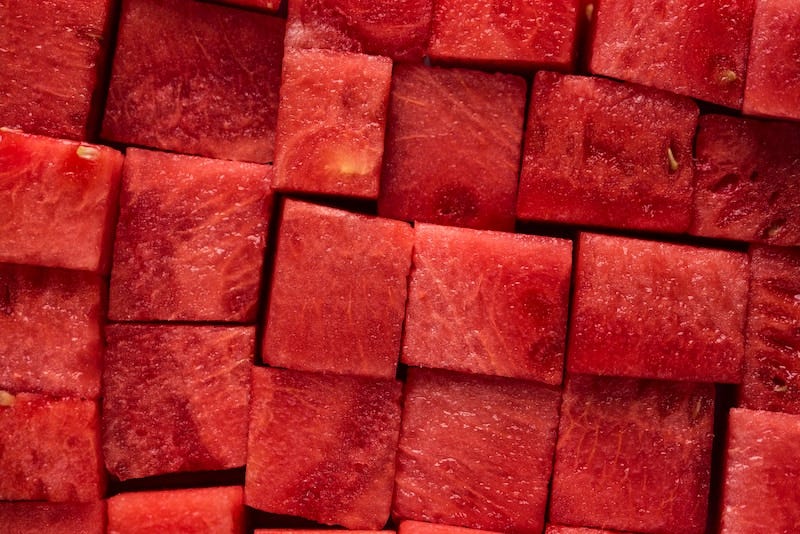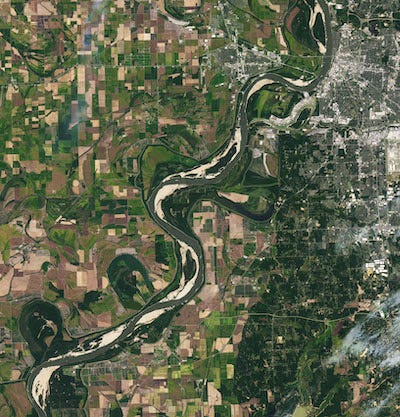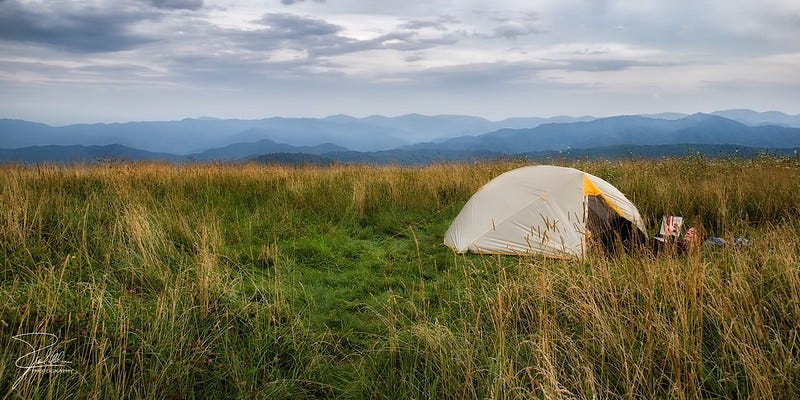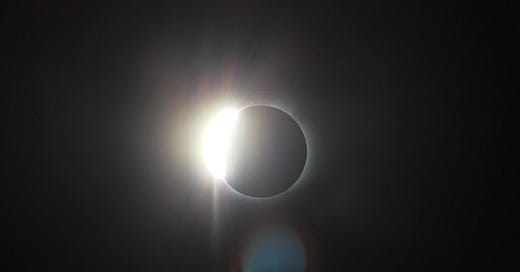Get out there
Sure, it’s been grim summer—and there’s trouble to come here in New Orleans, as I get into below. But before we get too heavy, here’s some outdoor fun to consider…
New Orleans (Oct. 5): Lost Believers
For my New Orleans readers: come out to Blue Cypress Books at 6 p.m. on Thursday, October 5. I’ll be chatting with Alabama writer Irinia Zhorov about her new novel, Lost Believers—and about, I’m guessing, geology and storytelling and much more.
Everywhere (Oct. 14): Solar Eclipse
This year’s solar eclipse will mostly miss the South, though it will pass over Corpus Christi. (Outside suggests Padre Island as one of the best places in the country to see the eclipse.) Still, here in Louisiana, we’ll be able to see an eclipse of around 75%. Look up your local timing here.
Appalachia: Fall foliage
In one of the greatest examples of content marketing I’ve seen in a long time, SmokyMountains.com offers a fall foliage projection. This weekend, the southernmost Appalachians are projected to get one of the region’s first big flare-ups.
Memphis: Mississippi riverfront
If you’re anywhere near Memphis, it’s a good season to check out the newly renovated Tom Lee Park, which is one part of one of the most expansive public riverfront expanses along the Mississippi River.
Various: Autumn apples
Diane Flynt, the author of Wild, Tamed, Lost, Revived: The Surprising Story of Apples in the South, suggests five apples worth seeking. (With so few apples growing in southern Louisiana, perhaps I’ll settle for an apple cider donut.)
Reading list
Stories worth spending time with

1. The Wounded Fruit (Bitter Southerner)
In her latest story in her award-winning “Crop Cycle” series, Shane Mitchell looks at the tangled meanings assigned to the humble watermelon.
2. Florida has become a zoo. A literal zoo. (Vox)
As a part of a package on the strange state of Florida, Benji Jones examines the incredible abundance of “invasive” species—more here than in any other state—that have turned the place into “an unmanaged zoo [and] an uncontrolled experiment.”
3. Look Closely, or You’ll Miss It (Emergence)
“Birds are always looking for shelter—looking to thrive. Blacks came here in the same way by the thousands.” Poet Natalie Rose Richardson examines connections between birdwatching and the Great Migration.
4. The Kids on the Night Shift (New York Times Magazine)
I’ve written before about some of the ecological problems with chickens. But they’re a social problem, too. Hannah Dreier goes deep on a community in Virginia where the local chicken plants run on child immigrant labor.
The Saltwater Creep
Driving home from the airport last night, a sign flashed above the freeway: “Do your part to save the land,” it read. “Obey the burn ban.”
It’s an unusual warning, but, then again, this summer has been unusual, here and everywhere. The searing heat and drought helped spark a rare accumulation of Louisiana wildfires—more than 600 in August, including what is likely the largest in a century. (The good news: the statewide burn ban is now lifted; as of Friday, individual parishes were given permission to set their own rules.)
New Orleans, soggy and hurricane-wracked, has always felt like an apocalyptic city, but lately that’s been cranked to eleven. Trees are falling across the city—sometimes to tragic effect. Dead fish are washing up on our shores.
The big news, of course, is the slow creep of saltwater making its way up the Mississippi. The maps tracking its progress bring to mind a war movie: here is an invasion, an alien world sneaking into our own.
The hydrology behind the problem is simple. The Mississippi is deep, and from Natchez south, the riverbed is below sea level. Typically, the river’s mighty blast of water keeps saltwater at bay, but a nationwide drought has the river at record lows. So a tongue of salt water is snaking upstream. On September 20, it overtopped an underwater dam built by the Army Corps of Engineers. When it hits New Orleans’s water intake, we’ll lose our drinking water—for as long as three months. The saltwater might raise the risk of lead poisoning, too. It’s hard to overstate the scale of the crisis.


Given my publishing schedule, I am going to steer you elsewhere for the essential coverage. (WWNO offers an excellent, ongoing Q&A that answers reader questions about the wedge.) My interest lies more in considering what this says about our local relationship with nature.
It’s impossible to say what the river’s “natural” behavior would be, but we’ve certainly increased our risk here. Climate change is carrying sea levels upward. The riverbed, meanwhile, has been artificially deepened for the sake of ships.
The one bit of good news is that, at least according to one set of models, the extreme lows of the past two years are likely to become rarer in the coming years—so, despite our best efforts, this may not be the crisis we have to worry about in the future, at least in the short term. (In the long term, when the water one day diverts down the Atchafalaya, the flow of the Mississippi will be reduced to the extent that the saltwater wedge would become a permanent fixture.) (By the way: the Army Corps is currently inspecting the infrastructure that keeps the diversion from happening.)
There’s been some discussion of the “Kenner hump,” a kind of hill on the riverbed just upstream of New Orleans, which could block any further invasion—potentially giving the city a site, not so far away, from which to pump water. It’s a rare moment that we’re paying attention to the river’s hidden depths.
I was talking with a retired towboat captain recently, a man with deep respect for the river. He had a simple explanation for all our troubles on the Mississippi. It’s not climate change—or not only climate change. We simply have forgotten what we live along.
He told me that next time the river hits flood stage, I should go down to Jackson Square and watch everyone sipping their coffee at Cafe du Monde and watch the freighters pass overhead—“nothing between you and the great continental river but an earthen levee,” he said. At mid-river there, the water runs 250 feet deep. “That’s not a sensible scheme, is my opinion. I think it’s insane.”
Further reading
+ Over on Yale Environment 360, Andrew Lewis looks at a different Mississippi problem: the river’s determination to forge a new path near its mouth.
News around the Southlands

"The Patch is maxed”
Tight restrictions helped rejuvenate Max Patch, a popular hiking and camping outside of Asheville—which raises questions about how to manage public spaces as interest booms.
Abominable snakes
How should we tackle “one of the most intractable invasive-species management issues across the globe”? Maybe by holding snake rodeos in the Everglades. (Washington Post)
+ Invasive species cost the world billions and are responsible for three in five extinctions (New York Times)
+ But the idea that species can be “invasive” at all is contested. (Vox)
Okefenokee: a world icon
Amid a feud of titanium mining, the National Park Service has nominated the Okefenokee National Wildlife Refuge as a World Heritage Site. (Atlanta Journal-Constitution)
Quick hits
Sunscreens for Florida corals.
America needs more hunters.
Expect more EPA scrutiny on pesticides.
In North Carolina, a fight over fish and the dawn of a new lithium mine.
The peach state turns to citrus.
Suing for the gopher tortoise.
The feral horse debate.





